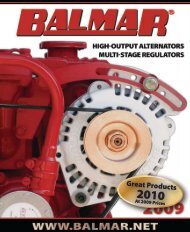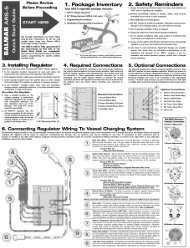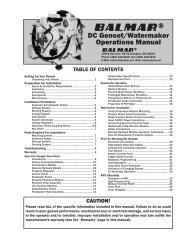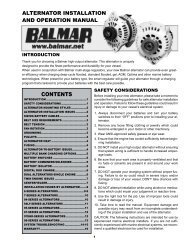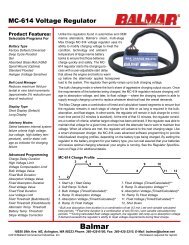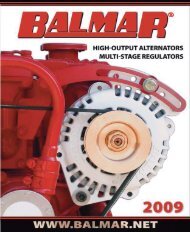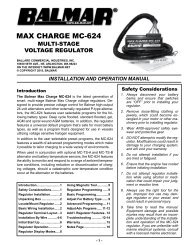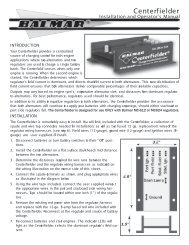8-Series Alternator - Balmar
8-Series Alternator - Balmar
8-Series Alternator - Balmar
Create successful ePaper yourself
Turn your PDF publications into a flip-book with our unique Google optimized e-Paper software.
80-<strong>Series</strong> <strong>Alternator</strong>s<br />
50, 65, and 100-A Models<br />
Model 81<br />
Basic ERS<br />
Regulator Included<br />
I. INTRODUCTION<br />
Your high-output BALMAR ® Marine <strong>Alternator</strong> is uniquely designed and<br />
engineered to provide the finest performance and durability for your vessel.<br />
Unlike most automotive-type alternators found standard on the majority of<br />
pleasure craft, BALMAR ® Marine <strong>Alternator</strong>s are specially designed to provide<br />
exceptional output at lower engine r.p.m.’s, so you can enjoy less noise and<br />
fumes, increased economy and shorter charge cycles.<br />
II. SAFETY CONSIDERATIONS<br />
Before installing your BALMAR ® marine alternator, please take a moment to<br />
consider the following guidelines for safe alternator installation. Failure to follow<br />
these guidelines could result in injury or damage to your electrical system.<br />
1. Always disconnect your battery’s ground cable and turn your battery switch<br />
to its OFF position prior to installing your alternator.<br />
2. Remove any loose-fitting clothing or jewelry, which could become<br />
entangled in your motor or other machinery.<br />
3. Wear ANSI-approved safety glasses.<br />
4. Do not attempt installation if tired or fatigued.<br />
5. Ensure the engine has cooled sufficiently before initiating installation.<br />
6. Drugs and alcohol do not mix with safe installation procedures. Do not<br />
attempt installation while using alcohol or any medication that could<br />
impair your judgment or reaction time.<br />
7. Always use the right tool for the job. In addition to causing damage to the<br />
alternator or your boat, the use of incorrect or improperly-sized tools can<br />
result in personal injury.<br />
8. Take time to read the manual. Equipment damage and possible injuries<br />
may result from an incomplete understanding of the installation and<br />
operation of the alternator.<br />
Model 812<br />
TABLE OF<br />
CONTENTS<br />
I. Introduction<br />
II. Safety Considerations<br />
III. General Information<br />
IV. Basic Installation<br />
V. Additional Installation<br />
Information.<br />
VI. Troubleshooting<br />
VII. Warranty<br />
VIII. Quick Installation<br />
Guide<br />
CAUTION<br />
The following instructions are<br />
intended for use by experienced<br />
marine electrical installers. If<br />
you are not experienced at<br />
installing electrical system<br />
components, we recommend a<br />
qualified marine electrician be<br />
used to install this alternator.<br />
19009 61st Ave. NE, Arlington, WA 98223 On the Web: http://www.balmar.net<br />
PHONE: (360) 435-6100 FAX: (360) 435-3210 E-MAIL: balmar@balmar.net<br />
- 1 -
III. GENERAL INFORMATION<br />
BALMAR ® alternators are available in a wide range of sizes, mounting configurations and amperage outputs to replace or upgrade a<br />
wide range of marine alternators. All BALMAR ® alternators are “P” type (positive on the field wire), with max field current demand 6 amps<br />
and 2.4 ohm rotors in 12/14 volt models.<br />
Amperage Ratings<br />
<strong>Alternator</strong>s are rated in relation to their outputs at our test bench at specific pulley r.p.m. Circuit breakers, fuses and wire gauges should<br />
be rated at or above maximum indicated alternator amperage. Actual amperages produced by the alternators after installation may vary<br />
due to factors such as battery capacity, battery type, wiring capacity, engine room temperature, and other variables. In most cases,<br />
maximum output is determined by your batteries’ absorption rates at their voltage set point.<br />
Voltage Regulation<br />
BALMAR ® alternators are engineered for external regulation. A basic, single-stage regulator, set at 14.1 volts, is included with each<br />
alternator. (Voltage can vary up to 3% plus or minus. Caution should be used when running for long periods when used with gel type<br />
batteries.) While the standard regulator supplied does provide an adequate charge control, we recommend a multi-step regulator for<br />
optimized charging. In addition to its ability to provide a smart charging protocol that’s tailored to your battery type, our Max Charge<br />
has the ability to monitor and compensate for temperature variation in both the alternator and your batteries (with optional sensors<br />
installed). Combined with amp management, soft ramp up and start delay, the Max Charge’s advanced programmability and multi-stage<br />
charging help provide the tools to increase charging speed and reduce engine and alternator wear.<br />
Rotation<br />
BALMAR ® marine alternators are designed to operate in a clockwise rotation (facing the pulley and fan). This clockwise rotation draws<br />
cool air from the back of the alternator across the internal components to maintain proper operating temperatures. Should the alternator<br />
be used in a secondary position (mounted in an opposing direction to the engine), or should the alternator be mounted on an “oppositerotation”<br />
engine, the alternator’s pulley must be keyed and/or pinned and the alternator must be equipped with a bi-directional fan.<br />
Reverse Rotation Kits are available for most BALMAR ® alternators.<br />
Grounding<br />
BALMAR ® 80-<strong>Series</strong> marine alternators are isolated ground. It is essential that the alternator is properly grounded. We strongly<br />
recommend you ground your alternator to the negative terminal of your house battery or your vessel’s ground buss with a cable that’s<br />
the same size as your output cable. Running your grounding cable directly to the engine’s ground bolt also provides a good source of<br />
ground. The regulator’s grounding wires must be attached to the alternator’s negative terminal (see Figure 4).<br />
Mechanical and Electrical Noise<br />
As part of normal operation, your BALMAR® marine alternator will make a slight whining noise while under load. This whining noise<br />
provides an indicator that the alternator is charging. In addition to a mechanical whine, you may experience a small amount of sticking<br />
or drag when the alternator is new. This is caused by the wood separators in the stator. With use, the separators will wear and the sticking<br />
will be eliminated.<br />
By nature, electricity producing equipment like alternators may create electrical noise or interference that can be transmitted to radios,<br />
radars and other voltage-sensitive electronics. Your BALMAR ® alternator has been designed to minimize electrical interference. If<br />
interference persists, we recommend adding noise reduction filters to your system. One provider of quality noise reducing filters is Marine<br />
Tech, Inc., at (800) 772-0796.<br />
Figure 1<br />
Wire Size<br />
Proper wire size is essential for safe and effective<br />
alternator operation. The accompanying Voltage drop<br />
chart provides a basic guide that should be used when<br />
determining proper wire lengths for charging systems<br />
(see Figure 1). Wiring used should be marine quality<br />
AWG boat cable, rather than SAE automotive wire.<br />
Marine-quality wire is normally tinned or treated to<br />
protect against the corrosive marine environment. Use<br />
only wire that is marked with size and type. In addition<br />
to wiring, all connectors used in vessel installations<br />
should also be manufactured for marine use.<br />
When determining the proper wire size for your<br />
installation, wire length should be measured by the<br />
distance required to reach from the positive (+) power<br />
source to the electrical device and back to the negative<br />
power connection. The chart to the right provides a<br />
general guide for wire size. If your specific wiring<br />
requirement falls between the values shown, use the<br />
larger wire size recommended. Contact the ABYC, BIA<br />
or your marine electrician for additional information.<br />
- 2 -
<strong>Alternator</strong> Heat<br />
During operation, your alternator may reach temperatures of 200 degrees as a result of inductive currents. In some instances, particularly<br />
during extended periods of heavy load, temperatures can reach 225 degrees (F). Temperatures exceeding that may result in damage. If<br />
your system is operating with a Max Charge regulator with optional alternator temperature sensing, the regulator will automatically shut<br />
off the alternator when temperatures pass set values, giving the alternator the ability to cool to normal temperatures before returning to<br />
operation. While this is an extremely effective device for alternator protection, it should not be used as part of normal alternator<br />
maintenance. Continual alternator overheating indicates ventilation or charging system problems and repair is strongly advised.<br />
Use extreme caution when handling the alternator or other engine components during or after use. Should your alternator become so<br />
hot that it emits a burning smell, or if there is indication of discoloration at the pulley or pulley shaft, shut off the alternator immediately<br />
and (once it becomes safe to inspect the alternator) check the tension of the drive belt. Under-tensioned belts are a leading cause of<br />
overheating and alternator damage. For more information, see the Maintenance section of this manual.<br />
Pulleys and Belts<br />
A 2.5'' deep V pulley is included with your alternator. This pulley will accommodate from 3/8" to 1/2" single belts or metric equivalents.<br />
Belts are not created equally, and in most instances you get what you pay for. Premium quality belts such as Gates’ "Tri-Power" or “Green<br />
Stripe”, Dayco’s “Topco”, or similar industrial-quality belts will provide a better value over lesser quality belts in both dependability and<br />
durability. We strongly recommend you always carry a spare belt as part of your emergency kit. <strong>Alternator</strong>s rated at 75-amps or less<br />
should use a minimum belt size of 3/8''. <strong>Alternator</strong>s rated at 100-amps should use a minimum belt size of 1/2''.<br />
IV. BASIC INSTALLATION<br />
CAUTION: <strong>Alternator</strong> installation requires substantial amount of mechanical and electrical understanding. If you are not experienced<br />
with alternator installations we strongly recommend that you enlist the services of a qualified marine electrician. Keep in mind that<br />
alternator performance is only as good as the wiring and battery installation. If you are unsure of the condition of your boat’s batteries<br />
or wiring, please have them inspected by a qualified electrician before proceeding with the alternator installation.<br />
<strong>Alternator</strong> Mounting<br />
Due to the many domestic and international configurations of engine/alternator mounts, and factors such as year and location of engine<br />
manufacture and marinization, BALMAR® cannot guarantee a drop-in replacement in every circumstance. Choose the BALMAR® model<br />
that most closely fits your application. Your installer may have to adapt the basic mounts to fit your needs. The majority of marine engines<br />
are equipped with one of two alternator mounting styles (shown in Figures 2-3). To determine your alternator requirement, compare your<br />
present alternator to those shown below. The single, 1-inch model is typically a replacement for “Motorola®” style alternators. Single,<br />
two-inch foot models generally replace Delco® style alternators.<br />
Once you have determined that the new alternator is the correct replacement for your existing model:<br />
1. Turn off batteries, disconnect the ground and<br />
detach the wiring from the existing alternator.<br />
2. Loosen the mounting bolt and remove the existing<br />
alternator.<br />
3. Once the alternator is disconnected from the<br />
engine, compare its mounting points to those on<br />
your new BALMAR® alternator. In most<br />
applications, the new alternator will replace the<br />
old alternator without any modification. In some<br />
cases, a simple bracket can be fabricated by a<br />
local machine shop. BALMAR ® offers a universal<br />
mounting arm which may solve some mounting<br />
challenges. Others can be obtained through your<br />
local auto or marine supply.<br />
Single Foot - 1” Mount<br />
Figure 2 Figure 3<br />
Single Foot - 2” Mount<br />
4. Attach the mounting foot of the new alternator to<br />
its engine mount. Some shimming may be<br />
necessary to ensure that the alternator is securely mounted within the engine mount. If your alternator is a dual foot style, use<br />
care when tightening the alternator in place that the two mounting ears are not compressed. The rear bushing is designed to slide<br />
to tighten the mount.<br />
5. Once in place, inspect to ensure that the alternator pulley is properly aligned with the engine pulley. If your belt configuration<br />
includes the pulley for the water pump, make sure that all three pulleys are properly aligned.<br />
6. Your new alternator is shipped with a simple, single-stage regulator with six wires connected to its epoxy potting. (See Figure 4.)<br />
The wiring is arranged as follows:<br />
a. Brown (Br) Ignition (source) Wire: Attaches to the auxiliary side of the vessel’s ignition switch, or an independent oil pressure<br />
switch to turn on regulator. Used when the orange wire is NOT used.<br />
b. Orange (O) Lamp Wire: This wire turns on the regulator when connected to a warning lamp that is connected to the aux.<br />
side of the key switch (optional). Used when the brown wire is NOT used.<br />
- 3 -
c. Blue (B) Field Wire: Attaches to the positive<br />
field terminal on the alternator as shown in<br />
Figure 5.<br />
d. Red (R) Sensor Wire: Attaches to the<br />
positive terminal of the battery, positive<br />
output of the alternator, common terminal<br />
of the battery switch, or the battery side of<br />
an isolator (if used).<br />
e. White (W) Stator Wire: Attaches to the<br />
Stator terminal on the alternator as shown<br />
in Figure 5. If an electric tachometer is<br />
used, an additional white wire should be<br />
run from the other stator terminal to the<br />
tachometer as shown in Figure 4.<br />
f. Black (Bk) Ground Wire: Attaches to the<br />
negative ground terminal as shown in<br />
Figure 4.<br />
7. Once the wiring is connected, attach the<br />
regulator to the alternator by bolting the angled<br />
tab at the bottom of the regulator to one of the<br />
1/4'' head bolts located next to the cover plate<br />
at the back of the alternator (as shown on the<br />
inset in Figure 4).<br />
8. Once the regulator and control wires are in<br />
place, the alternator’s positive output and<br />
negative ground cables should be attached.<br />
Positive output cable should be connected at the<br />
the bolt shown on Figure 4. The other end of the<br />
cable should be connected to the positive<br />
terminal of the battery, or the common output<br />
terminal of the battery switch if used with<br />
multiple battery banks. Refer to the Voltage Loss<br />
Table (Figure 1) to determine proper cable<br />
gauge.<br />
9. The ground cable must provide a sure<br />
connection to the batteries’ negative<br />
terminal. This can be accomplished<br />
by grounding the alternator directly<br />
to the negative battery terminal or to<br />
your engine’s grounding bolt. Be sure<br />
your cabling is the same size as that<br />
of the positive output.<br />
Smart Regulator Wiring<br />
Should you choose to upgrade your system<br />
to include the intelligent, microprocessor<br />
controlled Max Charge regulator or other<br />
BALMAR models, use Figure 5 as your wiring<br />
guide. In addition to its smart charging<br />
capabilities, the Max Charge regulator has<br />
the unique ability to automatically monitor<br />
battery and alternator temperatures and<br />
compensate for temperature changes<br />
outside of normal values (when used with<br />
optional temperature sensors). To install the<br />
alternator temperature sensor:<br />
1. Attach the positive and negative<br />
wires to the <strong>Alternator</strong> temperature<br />
Sensor terminals on the Max Charge<br />
regulator (see the Max Charge<br />
manual for terminal locations).<br />
Figure 5<br />
Figure 4<br />
- 4 -<br />
Choose only one of<br />
these two potential<br />
power sources.<br />
Mount regulator on<br />
rear of alternator as<br />
shown. Regulator<br />
can be mounted on<br />
right or left side of<br />
the alternator.<br />
Alternative<br />
Regulators<br />
• Max Charge MC-612<br />
• Max Charge MC-412<br />
• ARS-4<br />
• BRS-2
2. Attach the heavy lug terminal to the mid case mount on your alternator. Due<br />
to the number of alternator configurations, some installations may vary.<br />
Pulley Attachment<br />
After the alternator is installed and the wiring connections are attached, inspect the<br />
pulley for proper tension. When changing pulleys or when using the factoryinstalled<br />
pulley, torque the shaft nut to 50-60 foot-pounds. The shaft nut measures<br />
15/16''. To install the belt:<br />
1. Loosen the adjustment arm bolt and alternator pivot assembly bolt.<br />
2. Fit a new, high-quality belt over the appropriate pulleys.<br />
3. Tension the alternator until the belt is securely tightened in place. Re-tighten<br />
the pivot assembly and tension arm bolts. To test tension, place a 15/16''<br />
wrench on the alternator shaft nut and apply pressure. If the pulley rotates<br />
without moving the belt, re-loosen the bolts, apply additional pressure and<br />
re-tighten. Repeat until the belt is properly tensioned. (See Figure 6.)<br />
When installation is complete, run the engine. Visually inspect the engine, while<br />
running, for evidence of poorly aligned pulleys and belts. Use caution to avoid hot<br />
or moving parts. Turn off the engine after approximately 15 minutes and re-inspect<br />
the belt tension.<br />
V. ADDITIONAL INSTALLATION INFORMATION<br />
Battery Isolators<br />
Battery isolators may be used with any BALMAR ® alternator. Its capacity must equal the maximum alternator output. To compensate for<br />
volt drop, sensing must be on the battery side. If a dual-output alternator is used for more than two battery banks, each output must have<br />
its own dedicated isolator.<br />
Meters<br />
Most standard in-line Amp meters are UNDER-RATED for our alternators and should be removed from the system. Replace your existing<br />
amp meter with a standard volt meter. Should you wish to read output Amps, a high capacity 0-100 or 0-200 amp external shunt-type<br />
meter should be installed. Digital meters like the Link 10 or Link 20 by Heart Interface are excellent tools for charging system monitoring.<br />
Tachometers<br />
The alternator tachometer is energized by the pulse frequency generated by the alternator, which in turn is dependent on the alternator's<br />
rotor speed. BALMAR ® 80-<strong>Series</strong> alternators feature 12-pole construction. Most standard tachometers are engineered for engines with<br />
alternator pulley to crankshaft ratios of 1.8 to 2.8 to 1 on alternators with 12 poles.<br />
Figure 7<br />
The AC terminal or stator terminal may be used for electric tachometers not equipped their own<br />
sending unit. Tachometers will have to be adjusted and calibrated as necessary. We suggest<br />
running the engine up to a cruise RPM (2000), marking the throttle position BEFORE the original<br />
alternator is disconnected. After the installation is complete, run throttle up to mark and set the<br />
tachometer to its appropriate RPM. If you cannot set your existing tachometer, a programmable<br />
tach like the Teleflex Model 82430P should be considered as a replacement. Should bouncing<br />
of the tachometer be observed when the batteries are fully charged, turning on some DC loads<br />
will often cure the problem.<br />
Output Connections<br />
The most efficient output connection is a direct wire between the alternator and the battery. If your<br />
battery switch is closer to the alternator than the batteries, you may connect the output cable to<br />
the common output terminal. DO NOT turn the battery switch off when the engine is running.<br />
Severe damage to the diodes and the regulator could result.<br />
Fusing<br />
Figure 6<br />
Proper fusing of the charging system is required by ABYC standards. BALMAR ® recommends that the alternator outputs be protected by<br />
a fuse or manual reset circuit breaker. BALMAR ® 75, 100 and 150-amp circuit breakers are available at your local marine supply or may<br />
be special ordered through BALMAR ® . (See Figure 7.) If the alternator is connected directly to the battery, the breaker should be located<br />
close to the battery terminal.<br />
VI. TROUBLESHOOTING<br />
Determining the causes of failures in an electrical system is usually a “trial and error” process. We recommend that you begin<br />
your search by determining if the failure can be attributed to one or more of the most common causes of charging system failure:<br />
damaged wiring, damaged connectors, worn or damaged belts, worn or overly sulfated batteries, or bad grounds.<br />
- 5 -
A general inspection of the following conditions prior to testing will ensure the accuracy of your test results. Before testing:<br />
1. Remove and clean all charging system electrical connections (this includes the ground side). Also check the harness for<br />
resistance. The wires or terminals may become corroded and need to be cleaned or replaced.<br />
2. Charge all batteries to their proper fully charged state and determine if they are serviceable. If your batteries are floodedtype,<br />
use your hydrometer to determine their condition.<br />
3. Check and tighten alternator belt. If the belt shows signs of wear or damage, now if an ideal time for replacement. Always<br />
replace existing belts with the finest quality replacements available.<br />
After determining that your batteries and wiring are in suitable condition, use the following tests to determine if charging problems<br />
are a result of a faulty alternator or regulator. The following tests provide an opportunity to isolate the alternator, regulator and<br />
wiring harness in order to determine which component may be malfunctioning. If you are using the Max Charge regulator, please<br />
refer to the troubleshooting instructions included in the Max Charge’s instruction manual.<br />
Regulator Field Test<br />
The following tests are intended to help determine what part of your charging system may be experiencing difficulties. When<br />
testing voltage, ensure that your voltmeter is adjusted to its 12V setting. Use the space below the “Expected Reading” to keep<br />
track of your own readings.<br />
First Test (Engine Off) - The functionality of the regulator, harness and alternator can be tested by determining if a magnetic field<br />
exists at the alternator’s pulley shaft. To test:<br />
1. With the ignition in the OFF position, place the head of a steel screwdriver near the nut on the pulley shaft. There should<br />
be no evidence of a magnetic field pulling the screwdriver toward the alternator.<br />
2. With the ignition in the OFF position and your voltmeter’s negative probe applied to the alternator’s grounding bolt, check<br />
for voltage on the RED (sensing), BLUE (field) and BROWN (ignition) wires by inserting the positive lead of the voltmeter<br />
alongside each wire at the terminal at the back of the alternator or (in the case of the brown wire) at an applicable wire<br />
connection. The voltmeter should read:<br />
Red Wire Brown Wire Blue Wire<br />
Expected Reading 12 V * 0 V 0 V<br />
Your Reading<br />
* 11.5 - 12.8 VDC battery voltage at rest (no charging occurring). If your batteries are isolated and your RED (sensing) wire shows voltages other than<br />
those shown above, make sure that the wire is connected on the “battery” side of the isolator. The RED wire must “see” the battery directly.<br />
3. Once you have measured voltage at the three wires and have determined that there is no magnetic field at the pulley shaft<br />
or rear bearing, turn your ignition switch to its ON position (without turning on the engine). If your regulator is activated by<br />
an oil pressure switch, turn on your engine (Caution: if the engine must be run during these tests, use extreme caution to<br />
avoid contact with moving parts or hot engine or alternator surfaces.)<br />
4. Place the head of a steel screwdriver near the nut on the pulley shaft.DO NOT attempt this test with the motor running!<br />
There should be evidence of a magnetic field pulling the screwdriver toward the alternator. If magnetic field is present, the<br />
regulator is working properly, as well as the alternator’s rotor and brushes.<br />
5. With the ignition in the ON position (engine not running - except in cases of oil pressure switched circuits) measure the<br />
voltage at the same three wires as before. The voltmeter should read:<br />
Red Wire Brown Wire Blue Wire<br />
Expected Reading 12 V* 12 V 7 - 12 V<br />
Your Reading<br />
* 11.5 - 12.8 VDC battery voltage at rest (no charging occurring). If your batteries are isolated and your RED (sensing) wire shows voltages other than<br />
those shown above, make sure that the wire is connected on the “battery” side of the isolator. The RED wire must “see” the battery directly.<br />
Once the voltage is measured with the ignition on and the engine off, the engine can be started for the final regulator test. To<br />
collect your final readings:<br />
1. With the ignition in the ON position and the engine running, measure the voltage readings at the Red, Blue and Brown<br />
wires. The voltage values should read as follows:<br />
Red Wire Brown Wire Blue Wire<br />
Expected Reading 12 - 14V** 12 V 4 - 12 V<br />
Your Reading<br />
** 13.5 - 14.5 VDC battery voltage when charging.<br />
This completes the regulator test. If the voltages measured at your regulator match those target readings shown in the tables above,<br />
and if the alternator produces a magnetic field, the regulator and harness are working correctly. The presence of a magnetic field<br />
is also an indicator that the alternator rotor and brushes are functioning correctly. If one or more of the voltage readings are<br />
substantially different than the target readings shown above, the regulator or harness may be damaged or defective.<br />
- 6 -
<strong>Alternator</strong> Field Test<br />
Figure 8<br />
By eliminating the regulator from the charging circuit, it is possible to determine if<br />
charging failure is caused by the alternator. Testing the actual output of the<br />
alternator is known as “Full Field Testing”. This can be accomplished by jumping a<br />
positive12VDC current to the field terminal at the rear of the alternator. This test<br />
eliminates both the regulator and the harness, making it easier to isolate your<br />
investigation to the alternator. CAUTION: Voltage is unregulated during this test and<br />
could damage sensitive electronics. Ensure that all voltage sensitive equipment is<br />
turned off and any connections between the alternator and the regulator are<br />
disconnected prior to starting the engine. To test the alternator:<br />
1. Disconnect the BLUE (field) wire from the alternator. Attach shielded alligator<br />
clips to both ends of a test wire.<br />
3. Attach one end of the test wire to the alternator’s field terminal and attach the<br />
other end to the positive output of the alternator (see Figure 8). (If an isolator<br />
is used, jump to the field from the battery side of the isolator.) CAUTION: Do<br />
not allow the wire to contact the case while it is attached to the positive post.<br />
4. The motor should be run long enough to determine that charging voltage is<br />
present. Unregulated voltage can rise quickly. Do not allow extended<br />
unregulated charging to occur without carefully monitoring voltage levels.<br />
If the alternator fails to generate voltage during full field testing, an alternator malfunction is likely. Contact your local alternator<br />
repair shop or <strong>Balmar</strong>’s technical service staff for recommendations.<br />
Conclusion<br />
If your readings differ substantially from the “Expected Readings” listed in the charts above, the regulator may be malfunctioning,<br />
or there may be a continuity problem. Contact our technical support staff at (360) 435-6100. Keep your recorded readings in the<br />
spaces provided below the “Expected Readings” so you can share them with the technical support person.<br />
If the preceding tests do not prove the existence of a failure within the regulator or alternator, we recommend you contact a<br />
licensed marine electrician who can test your system for wiring and circuit damage or other system failures that could be<br />
responsible for charging difficulties. If you determine that repair service is necessary for either your alternator or regulator, please<br />
gather the following information before contacting our service technicians.<br />
1. Model of alternator.<br />
2. Model of voltage regulator.<br />
3. Voltage readings on red, brown and blue wire at regulator with engine off, key on.<br />
4. Voltage readings on red, brown and blue wire at regulator with engine running at a fast ideal 1400 rpm.<br />
VII. LIMITED PRODUCT WARRANTY<br />
BALMAR warrants to the original consumer/purchaser the product is free from any defects in material or workmanship for a period of one year from the date<br />
of purchase. If any such defect is discovered within the warranty period, BALMAR will replace the regulator free of charge, subject to verification of the defect<br />
or malfunction upon delivery or shipping prepaid to BALMAR.<br />
This warranty DOES NOT apply to defects or physical damage resulting from abuse, neglect, accident, improper repair, alteration, modification, or<br />
unreasonable use of the products resulting in breakdown, cracked or broken cases nor are parts damaged by fire, water, freezing, collision, theft, explosion,<br />
rust, corrosion or items damaged in shipment in route to BALMAR for repair. BALMAR assumes no responsibility for consequential damage or loss or expense<br />
arising from these products or any labor required for service or repair.<br />
BALMAR WILL NOT repair or be held responsible for any product sent without proper identification and return address or RA number clearly marked on the<br />
package. You must include proof of date and place of purchase (photocopy of purchase invoice) or we cannot be responsible for repairs or replacement. In<br />
order to expedite warranty claims more efficiently, BALMAR asks that prior to returning a defective product for repair, you call their customer service department<br />
for a warranty return authorization number .<br />
If factory service is required, you can contact our BALMAR Customer Service Department Monday through Thursday, 7:30 AM to 5:30 PM, (PST)1-360 435-<br />
6100 ext “3”.<br />
Material required for the repair or replacement for the defective part or product is to be supplied free of charge upon delivery of the defective regulator to<br />
BALMAR, 19009 61st Ave. NE, Arlington, WA 98223. Customer is responsible for all return transportation charges and any air or rush delivery expense.<br />
BALMAR reserves the right to determine whether to repair or replace defective components.<br />
THE ABOVE LIMITATIONS MAY NOT APPLY TO YOU. SOME STATES DO NOT ALLOW LIMITATIONS ON HOW LONG AN IMPLIED WARRANTY LASTS.<br />
NO PERSON, AGENT, DEALER IS AUTHORIZED TO GIVE ANY WARRANTY<br />
BALMAR 19009 61st Ave. NE, Arlington, WA 98223 Ph: (360) 435-6100, Fx; (360) 435-3210<br />
E-mail: balmar@balmar.net, Web: www.balmar.net<br />
- 7 -
VIII. QUICK INSTALLATION BASICS<br />
CAUTION: This BALMAR ® marine alternator is intended for installation by a qualified marine electrician. If you are not experienced<br />
at marine electrical installations, we strongly recommend investing in the services of a qualified technician. The following is a brief<br />
description of a typical alternator installation. Your installation may vary based on engine type and age. This basic guide is meant<br />
for quick reference and should not be used without first reading the rest of the manual. To install the alternator:<br />
1. Turn off the battery and disconnect the ground wire. Disconnect the wiring from the existing alternator.<br />
2. Loosen the mounting bolt and remove the existing alternator.<br />
3. Compare existing mounting points to those on your new BALMAR ® alternator. In most applications, the new alternator will replace<br />
the existing alternator without any modification. Some cases may require some bracket modification. BALMAR ® offers a universal<br />
mounting arm which may solve some mounting challenges. Others can be obtained through your local auto or marine supply.<br />
4. Attach the mounting foot of the new alternator to its engine mount. Some shimming may be necessary to ensure a secure mount.<br />
5. Inspect to ensure proper pulley alignment. If your belt also drives the water pump, ensure all pulleys are properly aligned.<br />
6. Your alternator is shipped with a simple, single-stage regulator. The wiring is arranged as follows:<br />
a. Brown (Br) Ignition (source) Wire: Attaches to the auxiliary side of the vessel’s ignition switch, or an isolated ground oil<br />
pressure switch to turn on the regulator. Used when the orange wire is NOT used.<br />
b. Orange (O) Lamp Wire: This wire provides power to the regulator when connected to a warning lamp (optional). Used when<br />
the brown wire is NOT used.<br />
c. Blue (B) Field Wire: Attaches to the positive<br />
field terminal on the alternator as shown in Figure 9<br />
Figure 9.<br />
d. Red (R) Sensor Wire: Attaches to the positive<br />
terminal of the battery, positive output of the<br />
alternator, common terminal of the battery<br />
switch, or the battery side of an isolator (if<br />
used).<br />
e. White (W) Stator Wire: Attaches to the Stator<br />
terminal on the alternator as shown in Figure<br />
9. If an electric tachometer is used, an<br />
additional white wire should be run from the<br />
other stator terminal to the tachometer as<br />
shown in Figure 9.<br />
f. Black (Bk) Ground Wire: Attaches to the<br />
negative ground terminal shown in Figure 9.<br />
7. Once the wiring is connected between the<br />
regulator and the alternator, the alternator’s<br />
positive output and negative ground cables should<br />
be attached. Positive output cable should be<br />
connected at the the bolt shown on Figure 9. The<br />
other end of the cable should be connected at the<br />
positive terminal of the battery. If your battery<br />
switch is closer to the alternator than the batteries,<br />
you may connect the output cable to the common<br />
output terminal. Refer to the Voltage Loss Table<br />
(Figure 1) to determine proper cable gauge.<br />
8. The ground cable must provide a sure connection<br />
to the batteries’ negative terminal. This can be<br />
accomplished by grounding the alternator directly<br />
to the negative battery terminal or to your engine’s<br />
grounding bolt. Be sure your cabling is adequately<br />
sized to match your amperage load.<br />
CAUTION: Always follow the safety<br />
guidelines outlined on Page 1.<br />
Mount regulator on<br />
rear of alternator as<br />
shown. Regulator<br />
can be mounted on<br />
right or left side of<br />
the alternator.<br />
®<br />
19009 61st Ave. NE, Arlington, WA 98223 On the Web: http://www.balmar.net<br />
PHONE: (360) 435-6100 FAX: (360) 435-3210 E-MAIL: balmar@balmar.net




